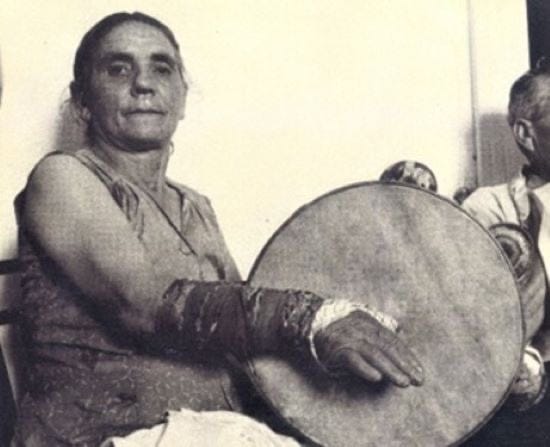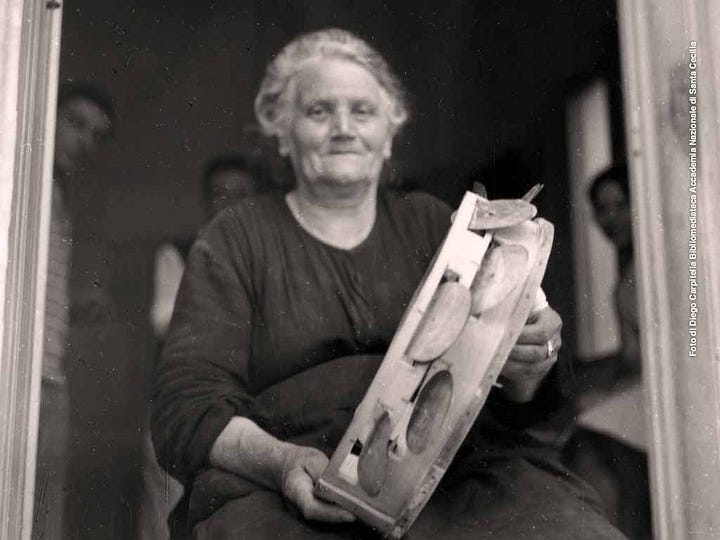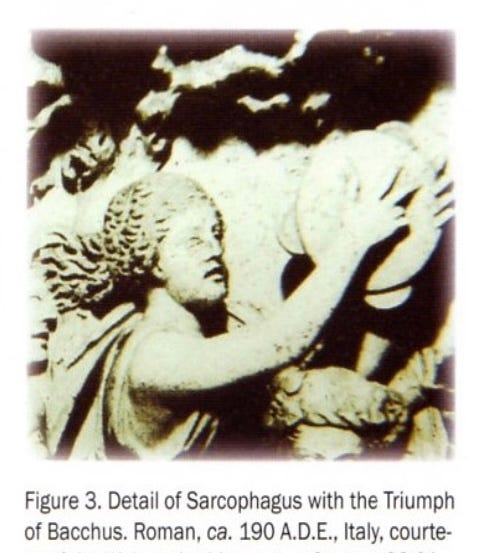A brief Introduction to the Italian tamburello
a brief introduction to Italy's many tambourines
If you have been to one of the many shows I’ve played over the years with my partner Rhiannon Giddens, then you will probably know that at some stage in the middle of the set I pick up a small tambourine and I start making jokes about the bad reputation that the tambourine has, and about the fact that I am about to try to convince you that it is a respectable instrument with a long history and tradition!
It’s all true, the tambourine these days is almost like a bit of a joke instrument, something that anyone picks up and shakes, and maybe hit their legs with while singing. But we don’t have to go so far back in time to realize that the instrument was hugely popular for a very long time and that this popularity came from hundreds of years of complex history and traditions.
In the US nowadays the fame of the tambourine has faded and I have seen it as a respected instrument with an unbroken tradition and a specific style only in Gospel music and in the city of New Orleans.
But if you leap over the ocean and enter the Mediterranean sea you will realise that this instrument still plays a huge role in the traditional music of literally every single country that touches this very sea and that it’s been there for thousands of years.
A tiny bit of condensed history
Frame drums are defined as instruments where the diameter of the drum head is larger than the width of the drum. We have statuettes of female goddesses holding a frame drum from central Asia that date back to 6.ooo years b.c. These types of frame drums are present in iconography from central Asian civilisations and later also in ancient Egypt and Greece.
Jingled frame drums appear in iconography for the first time during Greco Roman times in Italy.
During these times we start seeing the spread of tambourines throughout the Roman empire, and much later all the way up to central and northern Europe (where they became incredibly popular in the 18th-19th centuries). Most of the oldest iconography of frame drums features women holding these instruments. These were often divinities connected to fertility rites and the drum was associated with these sacred rituals. Until fairly recently these instruments were in fact mostly played by women all over the Mediterranean area, something that unfortunately has been almost lost in Southern Italy, where the majority of contemporary players are men.


In Italy we have many different styles of tambourine playing that survived over the centuries and they are mostly concentrated in the centre and south of the country.
In this brief survey I want to introduce you to the different techniques, the different types of music and, where possible, show you these instruments in their natural habitat.
I found this map online from 1990 from the Touring Club Italiano attempting to show the spread of the tambourine (in green) in Italy. The other instruments represented on this map are the Chitarra Battente (a traditional Italian steel string guitar) and the Ghironda (Hurdy Gurdy). I personally don’t think this map is very accurate and there seem to be many spots missing, but I decided to include it anyway as a reference for you to know where these regions are, as they will be mentioned later in this article.
Puglia
The first style of tamburello I was exposed to in my life is the one from Apulia (Puglia), and most specifically from the region of Salento (the most southern tip of the heel of the boot).
In this beautiful southern region the tamburello is a vital part of a style of music called Pizzica. Pizzica has had a huge revival that started in the 1970’s and it’s a style of music and dance that is popular throughout Italy these days, especially in “counter culture” environments.
A big part of the popularity and the myth around pizzica is the tradition of the drum used as an instrument for healing the bite of a spider through a form of ecstatic dance. This cultural phenomenon known as “Tarantismo” (connects to the musical genre Tarantella, the Tarantula spider and the city of Taranto) is believed to be directly connected to ancient Greek rituals and it was alive in this region until the 1960’s. I am sure most of you are familiar with the term Tarantella, which usually depicts a stylised form of dance music that became popular all over Europe from the 17th to the 19th centuries, and that always incapsulated most of southern Italian traditional music in one term. Tarantella and Tarantismo are too much a complex cultural conversation to start here, and I promise I will get back on this topic, but I want you to know that for these rituals the tamburello was always the most important instrument, and the sound of the jingles was a big part of the healing procedure.
The pizzica rhythm (and most Tarantella rhythms in fact) is almost always a very fast triplet (like a jig with turbo boost!) and the technique developed in this area features a sort of hand roll to achieve the speed and to create a constant flow of notes, emphasized by the jingles. The style also features a very powerful thumb slap at the centre of the drum with each beat, and this creates a sort of thumping heartbeat rhythm on the skin. It is quite a muscular style and the constant friction of the hand on the skin can cause your hand to bleed, therefore it is quite common to see players who perform for hours wearing a sort of bandage to protect their hand.
Have a look at my friends from canzoniere grecanico salentino perform a very fast pizzica indiavolata and take a look at the tamburello, here played expertly by Giancarlo Paglialunga.
Pizzica was used for healing the Tarantati/e but its main function was to accompany dancing in the everyday life. The style known as Pizzica pizzica is in fact used mostly to accompany a sort of freestyle dancing that is stylised to represent a courting ritual. The dancers are sort of chasing each other around but their bodies are never in contact.
Sicilia
Sicily was where I headed next in my early days of tamburello research. It is the region where my family is from, and for me it has one of the most advanced and virtuoso tamburello styles of Italy. Sicily never had the same traditional music revival as Puglia, so it is quite hard to find very good tamburello players and to witness real performances of traditional music in its natural habitat.
Have a look at this video here below where Fabio Tricomi shows the almost infinite variations on the basic triplet rhythm of the tarantella. Where tamburello from Puglia is all about power, trance and repetition, Sicilian tamburello is all about variation and virtuosity. It is actually a very sophisticated and complex style that somehow summarises all Italian techniques and it requires an incredible control of the left hand. It has unique features such has an open bass sound (like in Arabic drums) and many left hand shakes and trills. Fabio Tricomi is a virtuoso multi instrumentalist and musicologist that has a profound knowledge of everything traditional from Sicily. He has collected and condensed all local Sicilian tambourine styles from the elders and he has been teaching these techniques and making sure these traditions don’t die (I have learned from him too). Fabio collaborated with me in a special project called Zahr, which resulted in a CD that looks at the real and imagined connections between southern Italian music and other musics from the Mediterranean area. More info here
At the beginning of this video Fabio explains that this virtuoso piece was passed orally from generation to generation of tambourine makers and that it was used as a piece to show off the drums being sold.
In Sicily the tamburello plays often a duet with the bagpipe in a ballettu (little dance)
The Sicilian bagpipe is a double chanter mellow sounding instrument that you will find in the inland agricultural communities. Here a little sampler of these two instruments together as they perform dance music.
Campania
In Campania the tambourine is called Tammorra and it is the largest of Italian tambourines. The playing technique is quite different from any other region and it is also the only region where the main rhythmical figure is not a triplet. It is more of a duple meter, even though often there is an underlying swing feel to the groove that almost makes it sound like the subdivision is still a triplet (a bit like in jazz).
The tammorra is used for a style of music and dance called tammurriata, believed to be so old that it predates christianity. One particularity of tammurriata is that it is often a very unique mix of sacred and secular. Some tammurriata styles are dedicated to the different Madonnas from different towns in Campania, and each style has a specific melodic shape and a dance.
Have a look at some of the traditional tammurriata dance. The dancers are marking the beat with castagnette in their hands (castanets that are very different from the spanish ones) and the arm and wrists movement required to play these castanets is a big part of the dance.
Calabria
In Calabria the tamburello is used to play the tarantella, and it is perhaps the region where these traditional music and dance are still the most alive.
The Calabrian tarantella usually features a more staccato and articulated rhythm. The tambourines are quite small and played with a slap like technique (sometimes with the fist as well!)
Bagpipes are very common here too and often associated with tambourines
Marche - Lazio
Marche, Lazio, Abruzzo and Molise are neighbouring regions that share a traditional dance form called saltarello (often saltarella). The tamburello is very important to the performance of saltarello and usually it features a style where the fast triplet is played with a bounce on straight fingers.
The tamburello style of the Marche region is very unique as in addition to the standard triplet figure it features many variations including thumb trills and the “urlo”, a sort of screaming sound created with the friction between the right hand fingers and the skin. The tamburello Marchigiano is also one of the only Italian styles where your left hand thumb is inside a thumbhole and the drum gets spinned around in a sort of acrobatic way!
The Saltarello marchigiano can also feature a duple time figure played with knuckles which is incredibly similar to hand Bodhran style of Ireland (more on that another day). Check out this technique at about 0’13” in this video
Saltarello roughly translates as “jumpy”. You can easily guess why by looking at this video of saltarello dances from the Lazio region.
Modern players
The new generation of tamburello players has experimented with new techniques and new styles and has opened up the possibilities of this very versatile drum. Have a look at my friend Andrea Piccioni, who has developed a unique style mixing all Italian traditional techniques with Arabic, Indian concepts and techniques and contemporary drumkit grooves! I have been collaborating with Andrea for many years and he’s also part of the project called Zahr mentioned above.
As a curiosity I should mention that the tamburello is so popular in Italy that it is also a professional sport!!
It is a game similar to tennis where the players hold a frame drum (!!) instead of the racket and use it to hit a ball slightly larger than a tennis ball. A tamburello game generates a very unique sound!
You can read more about frame drums and tambourines in this article by Scott Robinson.
The best (and probably only) book written on the history of frame drums is
Mauricio Molina
Frame Drums in the Medieval Iberian Peninsula
2010, xviii, 200 pp.
(DeMusica 14)
ISBN: 978-3-937734-71-2








Hello, I have bult ,imported cajons and like all kinds of drumming.
Thais was a very welcomed and educational article and love the videos.
Thank you,
Lloyd
This is fantastic. I learned so much (Italian bagpipes?!). Thank you! I love Zahr and encourage anyone reading here who hasn't heard it to fix that right away.